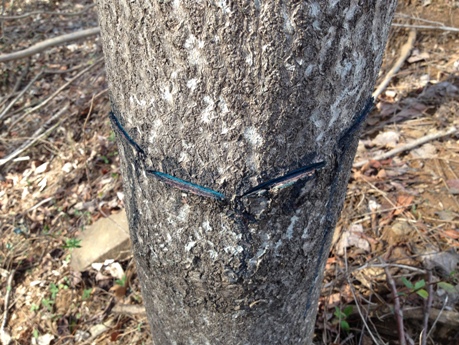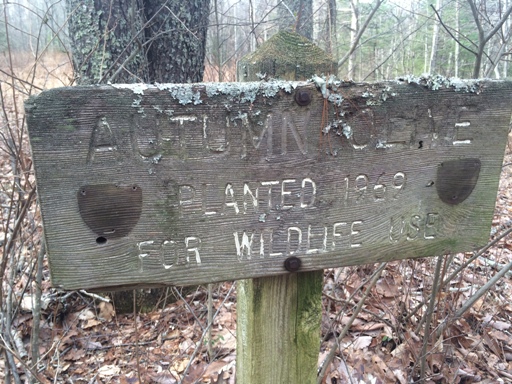Author’s Preface: I discovered quickly when writing this post that this topic cannot be done much justice in a short article. It is not my intent to imply right or wrong. My main goal is to say the issue is not as simple as some would like it to be and that we ought to refrain from a “one size fits all” approach. I would encourage everyone to delve into the issue more. The book “Invasive Plants: Guide to Identification and the Impacts and Control of Common North American Species” By Dr. Sylvan Kaufman and Wallace Kaufman(2007 – Stackpole Books)would be a good starting point if interested.
I had a great uncle who shall remain nameless. He wore an old hat covered with various pins and medals. After a drink or two on a Friday night my Dad tells me he would walk into a West Virginia backwoods bar, throw the hat on the floor and say “I’m going to whip anyone who touches that hat, and anyone who doesn’t grab it is a coward “ … but using more expressive language. He loved a good fight even though he weighed about 140 lbs. drenched. And there’s no better way to start one than to make a declaration, draw a line and dare someone to cross it.

Lately, one such line seems to be developing over non-native plants versus natives. On the surface it seems like a simple issue. After all, the first thing a person has to do to get out of a hole is to stop digging…right? So let’s just make a simple statement – use native plants always, no exceptions ever and be done with it. One thing we might quickly notice if we could make non-natives vanish instantly is that there would be no soybeans and cotton or red, white and crimson clover, along with yellow and white sweet clover would be gone from our continent. Not to mention the European honeybee.
And what about this word “invasive?” Just what is meant by that? I have spent the last 24 years of my life trying to elevate the appreciation for early-successional plants and habitats. By their very nature, they are invaders, which when they invade where we want them to we restate as “colonizers.” It is only when things start to appear where we do not want them that we use the term invaders. If you are a forester in Southside Virginia, you might consider the native redbud tree to be invasive when it takes over a newly planted pine stand. As defined by Executive Order 13112 – 1999: “An invasive species is a species that does not naturally occur in a specific area and whose introduction does or is likely to cause economic or environmental harm or harm to human health.”
There are obvious examples of plant introductions that have gone horribly wrong. I heard a biologist once lament “I wonder what’s going to happen when the ‘vine that ate the South’ – kudzu, meets the ‘vine that ate the North’ – mile–a-minute vine?”
There is a long list of early naturalists, scientists and even Founding Fathers who contributed. Thomas Jefferson wrote “The greatest service which can be rendered any country is to add a useful plant to its culture” (Randall 1994). The list of invaders is long, but some of the more notable in Virginia include ailanthus, Autumn olive, multi-flora rose, Johnson grass, sericea lespedeza, and phragmites. Over 50,000 species of plants have been introduced into North America since the beginning of European settlement. They provide 98% of our crops. Of the 50,000, about 5,000 have become competitors with over 17,000 native plants (Kaufman and Kaufman, 2007).

In the case of our Quail Team, we have been criticized for continuing to recommend the planting of the non-native Korean (Lespedeza stipulacea) and Kobe lespedezas (Lespedeza striata). Both are reseeding annuals that typically do not grow above knee high. In the mid-twentieth century hundreds of thousands of acres of these lespedezas were planted across the country primarily for hay. They were often referred to as “the poor man’s alfalfa” being cheaper to establish and maintain. Though I have never personally witnessed it, I am told they can become invasive. While alternative native legume seeds are available, they tend to be astronomically priced compared to Korean and Kobe lespedeza. We often recommend them in conjunction with the native annual partridge peas (Cassia fasiculata and Cassia nictitans). Our goal with all of them is to help provide some quickly establishing legumes to supplement a native seed bank that is often depleted.
Are we inadvertently altering an ecosystem? Or is the ecosystem already so altered as to make it hard to identify? One thing I do know is that during the 20 years I have worked for the Department of Game and Inland Fisheries, we have become much more conscious of the issue and much more careful about how we approach plantings. “Think before you plant” is not a bad mantra.
Rather than advocating “Natives only,” the National Bobwhite Conservation Initiative (NBCI) is advocating “Natives First” – meaning when good native options exist choose them first…whether for wildlife, hay or pasture. And further, they advocate that government cost-share programs should not help pay for establishing non-natives.
Quoting again from Kaufman and Kaufman 2007, “To see the invasive species issue as a choice between the native environment and alien species, between preservation and human meddling, obscures the real issue. All “native” dominants from ponderosa pine to American bison and the Canada goose were all once invaders. The invasive species issue is real, and environmental pessimists can take a major part of the credit for bringing it onto the public stage.
The heart of the matter, however, is not how to restore some “native” ecosystem. To do that would we choose from pre-Columbian, pre-Indian, ice-age or pre-ice age? The choice is arbitrary. We will make intelligent decisions only when the debate shifts from the unsupportable notion that “native” is always better to the all-important question of how do we manage change in that dynamic system of tradeoffs that is our natural economy.”
For my part I will continue to recommend Kobe lespedeza — but will point out that it is a non-native — and I’ll continue to battle ailanthus viciously, but I doubt I’ll try to do much about Japanese honeysuckle, … and I’ll continue to watch my bees enjoy white clover.
For those of you looking for some alternatives to non-natives here are a few: instead of bi-color or VA-70 lespedeza, try bristly locust or indigo-bush; rather than sericea lespedeza, try partridge pea or round head lespedeza; instead of oriental bittersweet, use coral honeysuckle, trumpet creeper or American bittersweet; rather than Chinese privet, use American holly; instead of multi-flora rose, use hawthorn; instead of Autumn olive, try Chickasaw and American plum; instead of sawtooth oak, try chinquapin, hazelnut, and white, red or other native oaks; and instead of fescue and orchard grass, use purple-top, little bluestem, and deer tongue (Condensed from Tarheel Wildlife, 2010). But before you plant anything, you might try waiting a year or two and just observing what you have in the local seedbank.
Literature cited:
Kaufman, S.R and W. Kaufman. 2007. Invasive plants: Guide to Identification and the Impacts and Control of Common North American Species. Stackpole Books.
Randall, W.S. 1994. Thomas Jefferson: A Life. New York: Harper Collins.
Sharpe, T. 2010. Tarheel Wildlife: A Guide for Managing Wildlife on Private Lands in North Carolina. North Carolina Wildlife Resources Commission.






